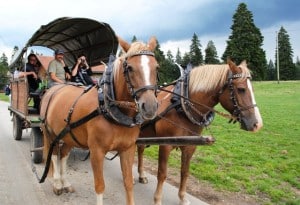
Traveling through the capitol of Bern, and north, to the banks of the River Aare, we arrived in Solothurn, known as Switzerland’s finest baroque town. I took in the fresh air and the beautiful French inspired architecture, as the town was the seat of France’s ambassadors to Switzerland from 1530 to 1792. I visited the artistically detailed St. Ursen Cathedral with its 11 altars and 11 bells. Solothurn was the 11th canton to join the Swiss Confederation and everything seems to come in elevens. I enjoyed walking through the charming town and photographing the sculptured, historic fountains and towers (all eleven of them!). It was early September and the street market was vibrant with colorful berries – the area’s specialty. My friends and I had lunch at an outdoor cafe, and then I checked out the boutiques, including an Absinthe shop. The herbs used to make this once banned liqueur come from the surrounding forests.
From Solothurn, we caught the train to Biel, also called Bienne, because it is equally French and German speaking. We boarded a boat on Lake Biel/Bienne to get to St. Peter’s Island, a nature preserve and once the home of philosopher Jean-Jaques Rousseau. The lake offered panoramic views of wineries and when we arrived, children were bathing. We walked the mile to Klosterhotel, where we enjoyed rosé wine made by a local monastery in the outdoor courtyard. The Swiss love nature and St. Peter’s island is a nature lover’s paradise. There is evidence of Roman occupancy that date back to the 8th century here, and in the 12th century it became a monastery. The island was very peaceful.
After our mile walk back to the van, we checked into Hotel de l’Aigle in Couvet for dinner served by the hotel owners and to sleep in the cozy 18th century hotel room. The hotel was small and family run, making us feel more like relatives than customers. It wasn’t five star, but I felt comfortable and the breakfast and dinner fare were good. I would definitely stay here again the next time I am in my favorite region of Switzerland.
After breakfast, we headed outside for a three hour hike in Le Creux du Van, a natural amphitheater. The challenging hike was mostly uphill and was led by a guide. The views were worth it! Sometimes chamois and ibex can be seen. We also hiked along the river in the Areuse Gorges, a little difficult because of the slippery path, but not steep, and saw idyllic bridges from a Hallmark card and dinosaur prints embedded in the rock. We were in the Jura region after all, named for the Jurassic period!
We stopped for refreshments at an outdoor cafe in the park, and bought house-made Absinthe to take back to the US. A van then transported us to Me’tairie des Plânes to a typical farm restaurant with magnificent views of the countryside. After lunch we had one more activity to do – the best saved for last! It was horseback riding on Franches-Montagnes horses, a breed unique to Switzerland. The breed is named after the mountain range and means “free mountains”. These horses are not only gorgeous, but the best horses I have ever rode. We began the trail ride in single file with all four riders following the lead horse and Swiss guide. I was riding Quinette, and she loyally followed our guide, thank goodness, because the older gentleman did not speak English. It was quite a ride, because during the easy ramble through the woods, the clouds darkened, actually turning purple – blue, and hail came from out of nowhere! The horses were afraid, but instinctively knew to go under the trees (but I am not sure it is the best spot for lightening! ?). Luckily it passed quickly and we all had rain gear on. The farm is in Le Bois, and almost borders France. You can also go on a horse drawn carriage ride.

Our last dinner in Switzerland was at Le Theusseret, on the River Doubs, in Goumois, along the French border. Their specialty is trout and my favorite -local chanterelle mushrooms, which are gathered in the forests and prepared with port wine and cream. It was one of the most memorable dishes that I tasted in Switzerland! Wines from the region, along with the house specialty of white wine infused with a berry syrup, were served. For dessert, double cream ice cream with espresso and absinthe for anyone who cared to try the potent licorice tasting aperitif.
On our final night we stayed at Hotel Le Cerneux-au-Maire, also owner-run and located in the town of Le Cerneux-au-Maire! The rooms of this country hotel were small but quiet. This is where bicycle enthusiasts, hikers, and cross country skiers lay their heads after an energetic day in the country.
In the morning, before heading back to Zurich to catch Swiss Air flights back home, we stopped at the nature preserve in Estavayer-le-Lac in the Grand Cariçae, near Yverdon. Located on Lake Neuchatel, the Grand Cariçae encompasses 40 km of nature preserve and is home to 300 species of birds. One third of Switzerland’s flora and fauna can be found here. Europe’s best wetland preserve can be explored by bicycle or on foot.
The Jura region offers nature with an abundance of outdoor activities amidst an ancient backdrop – an intriguing combination. Although less well known than other parts of Switzerland, it is truly worth discovering.
NOTE: This trip was sponsored in part by My Switzerland.









